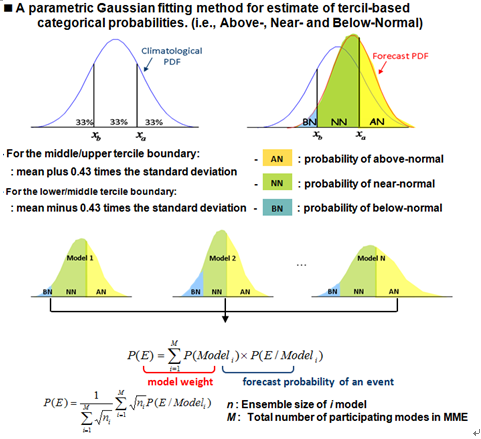Probabilistic MME
Go To Plot
Probabilistic forecast
The probabilistic multi-model ensemble prediction system used at WMO LC-LRFMME is based on an uncalibrated MME with model weights being inversely proportional to the random errors in the forecast probability associated with the standard error of the ensemble mean (i.e., proportional to the square root of model ensemble size), and a Gaussian fitting method for the estimation of tercile-based categorical probabilities (Min et al. 2009).
Probabilistic forecasts are issued in the form of tercile-based categorical probabilities (hereafter, tercile probabilities), that is, the probability of the below-normal (BN), near-normal (NN), and above-normal (AN) categories, with respect to climatology. A Gaussian approximation was applied to estimate tercile probabilities. The lower (  ) and upper (
) and upper (  ) terciles are estimated as
) terciles are estimated as  and
and  , respectively, with
, respectively, with  and
and  being the mean and standard deviation of the hindcast sample. Forecast probability of each category is estimated as a portion of the cumulative probability of the forecast sample associated with this category.
being the mean and standard deviation of the hindcast sample. Forecast probability of each category is estimated as a portion of the cumulative probability of the forecast sample associated with this category.

Multi-model combination
Two approaches are possible to developing of a probabilistic multimodel ensemble forecast on the basis of a set of model ensembles. The first approach is pooling and the second is to separately compute a probabilistic forecast for each individual model and then combine them. Because of the inconsistency between individual model weights in the GPC’s hindcast and forecast datasets, the second approach can be used for the operative WMOLC-LRF MME probabilistic forecast method. It implies that forecast probabilities for each tercile category are estimated separately for each individual model and then these forecast probabilities are combined by applying the total probability formula: .

 is j-event (i.e., either above normal (AN), near normal (NN) or below normal (BN)),
is j-event (i.e., either above normal (AN), near normal (NN) or below normal (BN)),  is the i-model, and Mis the number of models. In this equation, P(
is the i-model, and Mis the number of models. In this equation, P( ) is a forecast probability of the event conditioned on the i-model (i.e., the imodel forecast of j-event). M(
) is a forecast probability of the event conditioned on the i-model (i.e., the imodel forecast of j-event). M( ) is an unconditional probability of the model, which is a model weight in this context. Here, we assign the weight proportional to the square root of the model ensemble size
) is an unconditional probability of the model, which is a model weight in this context. Here, we assign the weight proportional to the square root of the model ensemble size , . Taking into account that model weights must sum up to one, the final forecast formula for each j-event is as follows .
, . Taking into account that model weights must sum up to one, the final forecast formula for each j-event is as follows .

References
Min, Y.-M., V.N. Kryjov, C.-K. Park, 2009: Probabilistic Multimodel Ensemble Approach to Seasonal Prediction. Weather and Forecasting, 24, 812-828
